Ryo Suzuki
MapStory: LLM-Powered Text-Driven Map Animation Prototyping with Human-in-the-Loop Editing
May 28, 2025Abstract:We introduce MapStory, an LLM-powered animation authoring tool that generates editable map animation sequences directly from natural language text. Given a user-written script, MapStory leverages an agentic architecture to automatically produce a scene breakdown, which decomposes the script into key animation building blocks such as camera movements, visual highlights, and animated elements. Our system includes a researcher component that accurately queries geospatial information by leveraging an LLM with web search, enabling the automatic extraction of relevant regions, paths, and coordinates while allowing users to edit and query for changes or additional information to refine the results. Additionally, users can fine-tune parameters of these blocks through an interactive timeline editor. We detail the system's design and architecture, informed by formative interviews with professional animators and an analysis of 200 existing map animation videos. Our evaluation, which includes expert interviews (N=5) and a usability study (N=12), demonstrates that MapStory enables users to create map animations with ease, facilitates faster iteration, encourages creative exploration, and lowers barriers to creating map-centric stories.
SLAMSpoof: Practical LiDAR Spoofing Attacks on Localization Systems Guided by Scan Matching Vulnerability Analysis
Feb 19, 2025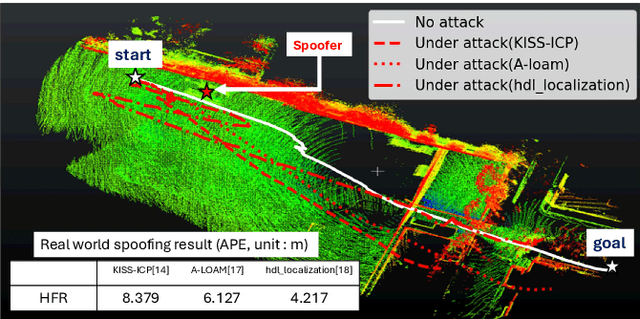
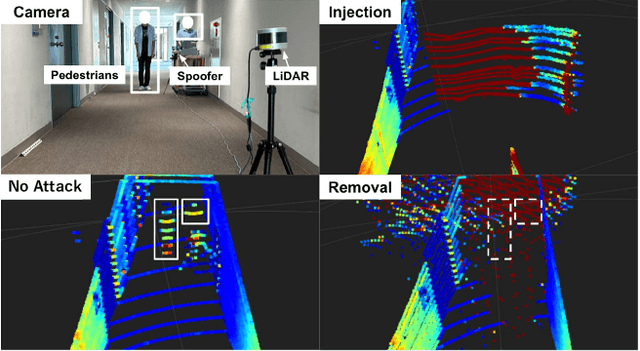

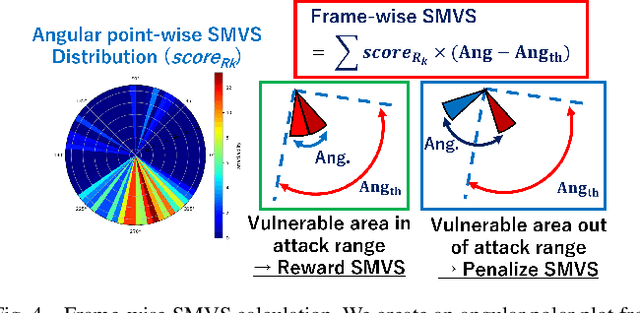
Abstract:Accurate localization is essential for enabling modern full self-driving services. These services heavily rely on map-based traffic information to reduce uncertainties in recognizing lane shapes, traffic light locations, and traffic signs. Achieving this level of reliance on map information requires centimeter-level localization accuracy, which is currently only achievable with LiDAR sensors. However, LiDAR is known to be vulnerable to spoofing attacks that emit malicious lasers against LiDAR to overwrite its measurements. Once localization is compromised, the attack could lead the victim off roads or make them ignore traffic lights. Motivated by these serious safety implications, we design SLAMSpoof, the first practical LiDAR spoofing attack on localization systems for self-driving to assess the actual attack significance on autonomous vehicles. SLAMSpoof can effectively find the effective attack location based on our scan matching vulnerability score (SMVS), a point-wise metric representing the potential vulnerability to spoofing attacks. To evaluate the effectiveness of the attack, we conduct real-world experiments on ground vehicles and confirm its high capability in real-world scenarios, inducing position errors of $\geq$4.2 meters (more than typical lane width) for all 3 popular LiDAR-based localization algorithms. We finally discuss the potential countermeasures of this attack. Code is available at https://github.com/Keio-CSG/slamspoof
Everyday AR through AI-in-the-Loop
Dec 17, 2024
Abstract:This workshop brings together experts and practitioners from augmented reality (AR) and artificial intelligence (AI) to shape the future of AI-in-the-loop everyday AR experiences. With recent advancements in both AR hardware and AI capabilities, we envision that everyday AR -- always-available and seamlessly integrated into users' daily environments -- is becoming increasingly feasible. This workshop will explore how AI can drive such everyday AR experiences. We discuss a range of topics, including adaptive and context-aware AR, generative AR content creation, always-on AI assistants, AI-driven accessible design, and real-world-oriented AI agents. Our goal is to identify the opportunities and challenges in AI-enabled AR, focusing on creating novel AR experiences that seamlessly blend the digital and physical worlds. Through the workshop, we aim to foster collaboration, inspire future research, and build a community to advance the research field of AI-enhanced AR.
SHAPE-IT: Exploring Text-to-Shape-Display for Generative Shape-Changing Behaviors with LLMs
Sep 10, 2024



Abstract:This paper introduces text-to-shape-display, a novel approach to generating dynamic shape changes in pin-based shape displays through natural language commands. By leveraging large language models (LLMs) and AI-chaining, our approach allows users to author shape-changing behaviors on demand through text prompts without programming. We describe the foundational aspects necessary for such a system, including the identification of key generative elements (primitive, animation, and interaction) and design requirements to enhance user interaction, based on formative exploration and iterative design processes. Based on these insights, we develop SHAPE-IT, an LLM-based authoring tool for a 24 x 24 shape display, which translates the user's textual command into executable code and allows for quick exploration through a web-based control interface. We evaluate the effectiveness of SHAPE-IT in two ways: 1) performance evaluation and 2) user evaluation (N= 10). The study conclusions highlight the ability to facilitate rapid ideation of a wide range of shape-changing behaviors with AI. However, the findings also expose accuracy-related challenges and limitations, prompting further exploration into refining the framework for leveraging AI to better suit the unique requirements of shape-changing systems.
Augmented Physics: A Machine Learning-Powered Tool for Creating Interactive Physics Simulations from Static Diagrams
May 28, 2024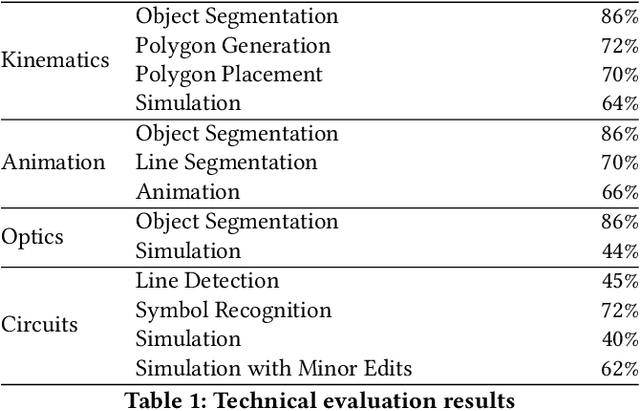



Abstract:We introduce Augmented Physics, a machine learning-powered tool designed for creating interactive physics simulations from static textbook diagrams. Leveraging computer vision techniques, such as Segment Anything and OpenCV, our web-based system enables users to semi-automatically extract diagrams from physics textbooks and then generate interactive simulations based on the extracted content. These interactive diagrams are seamlessly integrated into scanned textbook pages, facilitating interactive and personalized learning experiences across various physics concepts, including gravity, optics, circuits, and kinematics. Drawing on an elicitation study with seven physics instructors, we explore four key augmentation techniques: 1) augmented experiments, 2) animated diagrams, 3) bi-directional manipulatives, and 4) parameter visualization. We evaluate our system through technical evaluation, a usability study (N=12), and expert interviews (N=12). The study findings suggest that our system can facilitate more engaging and personalized learning experiences in physics education.
RealitySummary: On-Demand Mixed Reality Document Enhancement using Large Language Models
May 28, 2024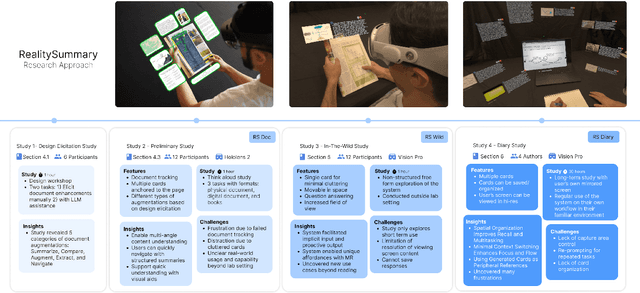
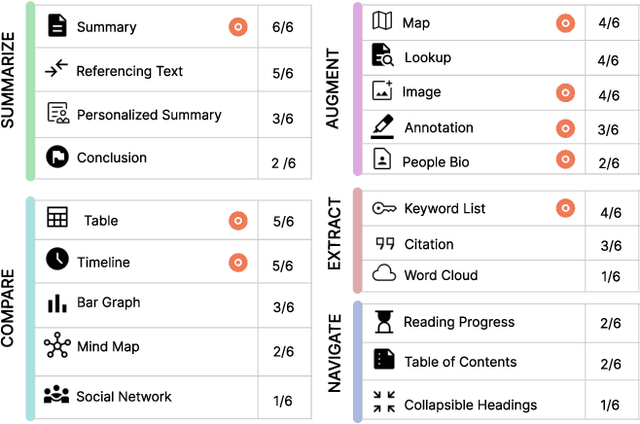


Abstract:We introduce RealitySummary, a mixed reality reading assistant that can enhance any printed or digital document using on-demand text extraction, summarization, and augmentation. While augmented reading tools promise to enhance physical reading experiences with overlaid digital content, prior systems have typically required pre-processed documents, which limits their generalizability and real-world use cases. In this paper, we explore on-demand document augmentation by leveraging large language models. To understand generalizable techniques for diverse documents, we first conducted an exploratory design study which identified five categories of document enhancements (summarization, augmentation, navigation, comparison, and extraction). Based on this, we developed a proof-of-concept system that can automatically extract and summarize text using Google Cloud OCR and GPT-4, then embed information around documents using a Microsoft Hololens 2 and Apple Vision Pro. We demonstrate real-time examples of six specific document augmentations: 1) summaries, 2) comparison tables, 3) timelines, 4) keyword lists, 5) summary highlighting, and 6) information cards. Results from a usability study (N=12) and in-the-wild study (N=11) highlight the potential benefits of on-demand MR document enhancement and opportunities for future research.
Augmented Conversation with Embedded Speech-Driven On-the-Fly Referencing in AR
May 28, 2024
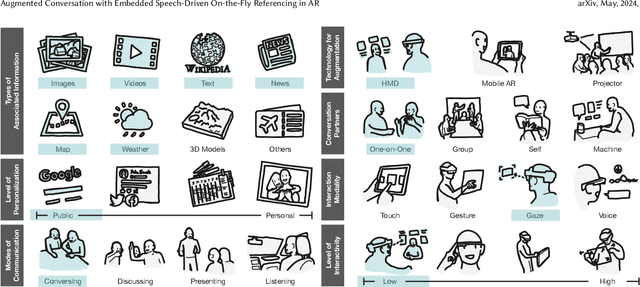
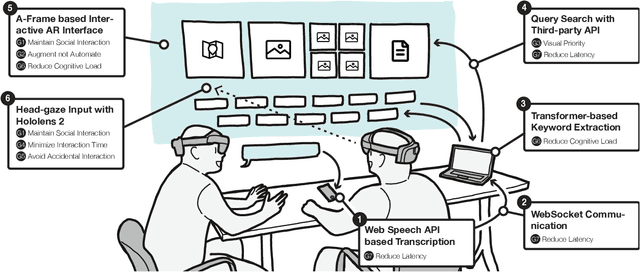
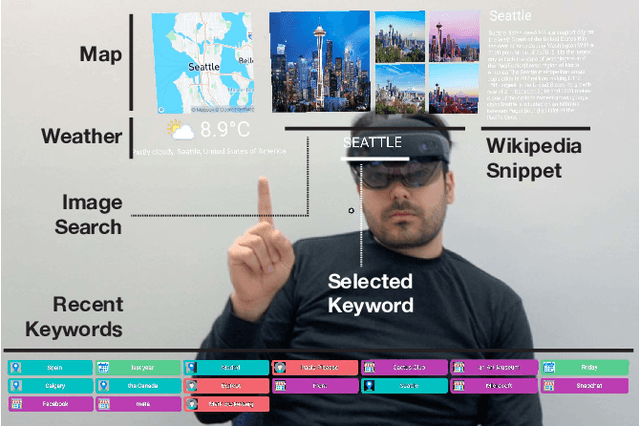
Abstract:This paper introduces the concept of augmented conversation, which aims to support co-located in-person conversations via embedded speech-driven on-the-fly referencing in augmented reality (AR). Today computing technologies like smartphones allow quick access to a variety of references during the conversation. However, these tools often create distractions, reducing eye contact and forcing users to focus their attention on phone screens and manually enter keywords to access relevant information. In contrast, AR-based on-the-fly referencing provides relevant visual references in real-time, based on keywords extracted automatically from the spoken conversation. By embedding these visual references in AR around the conversation partner, augmented conversation reduces distraction and friction, allowing users to maintain eye contact and supporting more natural social interactions. To demonstrate this concept, we developed \system, a Hololens-based interface that leverages real-time speech recognition, natural language processing and gaze-based interactions for on-the-fly embedded visual referencing. In this paper, we explore the design space of visual referencing for conversations, and describe our our implementation -- building on seven design guidelines identified through a user-centered design process. An initial user study confirms that our system decreases distraction and friction in conversations compared to smartphone searches, while providing highly useful and relevant information.
HoloBots: Augmenting Holographic Telepresence with Mobile Robots for Tangible Remote Collaboration in Mixed Reality
Jul 30, 2023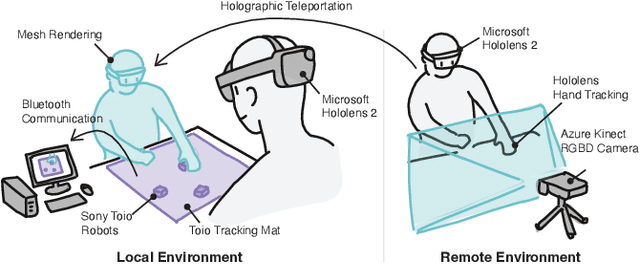
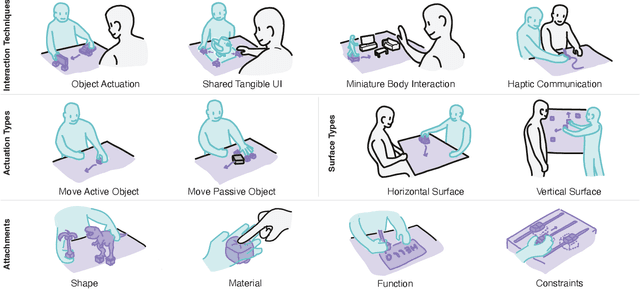


Abstract:This paper introduces HoloBots, a mixed reality remote collaboration system that augments holographic telepresence with synchronized mobile robots. Beyond existing mixed reality telepresence, HoloBots lets remote users not only be visually and spatially present, but also physically engage with local users and their environment. HoloBots allows the users to touch, grasp, manipulate, and interact with the remote physical environment as if they were co-located in the same shared space. We achieve this by synchronizing holographic user motion (Hololens 2 and Azure Kinect) with tabletop mobile robots (Sony Toio). Beyond the existing physical telepresence, HoloBots contributes to an exploration of broader design space, such as object actuation, virtual hand physicalization, world-in-miniature exploration, shared tangible interfaces, embodied guidance, and haptic communication. We evaluate our system with twelve participants by comparing it with hologram-only and robot-only conditions. Both quantitative and qualitative results confirm that our system significantly enhances the level of co-presence and shared experience, compared to the other conditions.
Augmented Math: Authoring AR-Based Explorable Explanations by Augmenting Static Math Textbooks
Jul 30, 2023



Abstract:We introduce Augmented Math, a machine learning-based approach to authoring AR explorable explanations by augmenting static math textbooks without programming. To augment a static document, our system first extracts mathematical formulas and figures from a given document using optical character recognition (OCR) and computer vision. By binding and manipulating these extracted contents, the user can see the interactive animation overlaid onto the document through mobile AR interfaces. This empowers non-technical users, such as teachers or students, to transform existing math textbooks and handouts into on-demand and personalized explorable explanations. To design our system, we first analyzed existing explorable math explanations to identify common design strategies. Based on the findings, we developed a set of augmentation techniques that can be automatically generated based on the extracted content, which are 1) dynamic values, 2) interactive figures, 3) relationship highlights, 4) concrete examples, and 5) step-by-step hints. To evaluate our system, we conduct two user studies: preliminary user testing and expert interviews. The study results confirm that our system allows more engaging experiences for learning math concepts.
Revisiting LiDAR Spoofing Attack Capabilities against Object Detection: Improvements, Measurement, and New Attack
Mar 19, 2023



Abstract:LiDAR (Light Detection And Ranging) is an indispensable sensor for precise long- and wide-range 3D sensing, which directly benefited the recent rapid deployment of autonomous driving (AD). Meanwhile, such a safety-critical application strongly motivates its security research. A recent line of research demonstrates that one can manipulate the LiDAR point cloud and fool object detection by firing malicious lasers against LiDAR. However, these efforts face 3 critical research gaps: (1) evaluating only on a specific LiDAR (VLP-16); (2) assuming unvalidated attack capabilities; and (3) evaluating with models trained on limited datasets. To fill these critical research gaps, we conduct the first large-scale measurement study on LiDAR spoofing attack capabilities on object detectors with 9 popular LiDARs in total and 3 major types of object detectors. To perform this measurement, we significantly improved the LiDAR spoofing capability with more careful optics and functional electronics, which allows us to be the first to clearly demonstrate and quantify key attack capabilities assumed in prior works. However, we further find that such key assumptions actually can no longer hold for all the other (8 out of 9) LiDARs that are more recent than VLP-16 due to various recent LiDAR features. To this end, we further identify a new type of LiDAR spoofing attack that can improve on this and be applicable to a much more general and recent set of LiDARs. We find that its attack capability is enough to (1) cause end-to-end safety hazards in simulated AD scenarios, and (2) remove real vehicles in the physical world. We also discuss the defense side.
 Add to Chrome
Add to Chrome Add to Firefox
Add to Firefox Add to Edge
Add to Edge